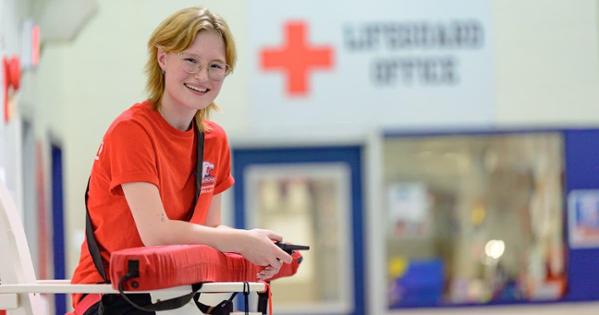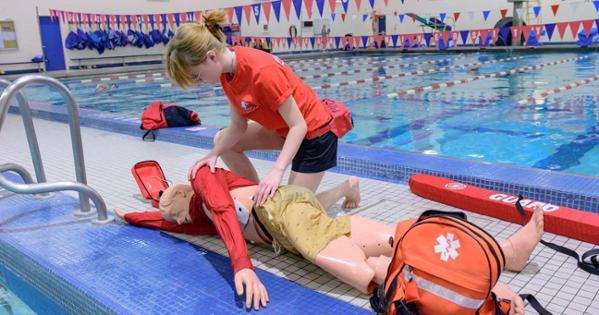Is There a Lifeguard on Board?

Teagan Odders, CAS/BS ’27, had just begun settling into her seat over the wing of a Southwest Airlines Boeing 737 when a shriek rang out.
Not long after the cabin door closed in preparation for takeoff, a commotion spurred an announcement. While still on the tarmac, the crew of the November 24 flight from Milwaukee to DC needed the help of anyone with medical training—and fast.
When the environmental science major looked in the aisle and didn’t see anyone get up, she wondered aloud whether she could help.
“I mean, I’m a lifeguard,” said Odders, who works a few shifts per week at AU’s Reeves Aquatic Center. “I don’t know if that counts.”
It did, her seatmate affirmed. Remembering her training, Odders joined a small group helping a flight attendant experiencing a tonic-clonic seizure—which causes a loss of consciousness and violent muscle contractions—at the front of the plane.
After another passenger administered anti-seizure medication, Odders led the group in rolling the flight attendant onto his side to open his airways and protect his head. “It’s the safest position for them,” Odders said.
According to the Centers for Disease Control and Prevention, 1 in 10 people will experience a seizure during their lifetime. Odders is grateful she could lend a hand and help prevent further complications from the seizure.
“I’d always known that this was a good skill set to have,” said Odders, who took a first aid class for the first time in high school, “but [this made me] think about how I could actually help in an [emergency]. I’m 18, and yet, I was the most qualified medical personnel on that plane.”
Although her flight was delayed, Odders made it back to campus safely later that night—and with a story to tell. The Wisconsin native called her mom, texted friends, and shared what happened in a group chat with fellow AU lifeguards.
She also shared the experience with her boss, AU aquatics facility manager Brenton Taylor, who has nominated Odders for a Lifesaving Award from the American Red Cross. The honor recognizes those who used skills taught by the Red Cross during a medical emergency.
Taylor said the quick action undertaken by Odders highlights the importance of first aid. “This training is lifesaving, but it’s also something you can carry with you for the rest of your life,” he said. “More people need to be CPR trained.”
At AU, all 36 student lifeguards are required to undergo a physical test and 28 hours of training, which includes the Red Cross’s CPR/AED for Professional Rescuers. That program teaches the skills necessary to keep swimmers safe and to respond to a variety of medical crises, including heart attacks, respiratory distress, airway obstructions, and seizures.
Training doesn’t end once the lifeguards complete the requirements necessary to don a whistle, however. Every week, Taylor randomly audits his staff by throwing a 6-foot mannequin named Wet Eddie into the pool. The exercise simulates how lifeguards would jump into action if a real swimmer needed help in AU’s aquatic complex, which includes an eight-lane, 25-yard lap pool and a three-lane, 20-yard teaching pool.
“Even though they get nervous when I do drills, a lot of [the lifeguards] heard Odders’ story and they understand now why I do what I do,” Taylor said. “I just want them to have the resources and to know how to use them.”
 In some small way, Odders said her own experience pulling a waterlogged Wet Eddie out of the pool prepared her for an unexpected situation while traveling. That training helped her remain calm under pressure.
In some small way, Odders said her own experience pulling a waterlogged Wet Eddie out of the pool prepared her for an unexpected situation while traveling. That training helped her remain calm under pressure.
“A good part of audits is you don’t know when it’s going to happen,” Odders said. “It really helps you get used to pushing through potential panic.”
Groups and individual students, faculty, and staff who are interested in CPR training at AU should reach out to Taylor at btaylor@american.edu. CPR certification is good for two years.
